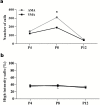Pregnancy at Advanced Maternal Age Affects Behavior and Hippocampal Gene Expression in Mouse Offspring
- PMID: 28329103
- PMCID: PMC5861961
- DOI: 10.1093/gerona/glx016
Pregnancy at Advanced Maternal Age Affects Behavior and Hippocampal Gene Expression in Mouse Offspring
Abstract
There is growing evidence that advanced maternal age is a risk factor for neurological and neuropsychiatric disorders in offspring. However, it remains unclear whether the altered brain programming induced by advanced maternal age is mediated by pre- or postnatal factors. Here, a mouse model was used to investigate whether pregnancy at advanced age may provoke behavioral and brain gene expression changes in offspring. Swiss Albino mice conceived by 3-month-old males and either 15-18-month-old (n = 11) or 3-month-old control females (n = 5), were delivered by cesarean section, fostered after birth by 3-month-old dams and subjected to a battery of behavioral tests. Furthermore, genome-wide mRNA expression was analyzed in the hippocampi of 4-month-old males offspring using microarrays. Offspring conceived by old mothers exhibited increased ultrasound vocalization activity during separation from the foster mother, increased anxiety-like behaviors in adult life, and altered patterns of hippocampal gene expression, compared to controls. These effects were not reversed by the postnatal maternal care provided by the young foster mothers, suggesting that the altered brain programming is already established at birth, consistent with prenatal effects related to maternal aging.
Keywords: Brain disorders; Delayed motherhood; Maternal effects.
© The Author 2017. Published by Oxford University Press on behalf of The Gerontological Society of America.
Figures



Similar articles
-
Maternal stress during pregnancy induces depressive-like behavior only in female offspring and correlates to their hippocampal Avp and Oxt receptor expression.Behav Brain Res. 2018 Nov 1;353:1-10. doi: 10.1016/j.bbr.2018.06.027. Epub 2018 Jun 26. Behav Brain Res. 2018. PMID: 29958961
-
Gender differences in short- vs. long-term impact of maternal depression following pre-gestational chronic mild stress.Exp Neurol. 2022 Jul;353:114059. doi: 10.1016/j.expneurol.2022.114059. Epub 2022 Mar 31. Exp Neurol. 2022. PMID: 35367456
-
Prenatal stress and early adoption effects on benzodiazepine receptors and anxiogenic behavior in the adult rat brain.Synapse. 2006 Dec 15;60(8):609-18. doi: 10.1002/syn.20336. Synapse. 2006. PMID: 17019679
-
Chronic maternal hyperglycemia induced during mid-pregnancy in rats increases RAGE expression, augments hippocampal excitability, and alters behavior of the offspring.Neuroscience. 2015 Sep 10;303:241-60. doi: 10.1016/j.neuroscience.2015.06.063. Epub 2015 Jul 4. Neuroscience. 2015. PMID: 26151680
-
Developmental fluoxetine exposure increases behavioral despair and alters epigenetic regulation of the hippocampal BDNF gene in adult female offspring.Horm Behav. 2016 Apr;80:47-57. doi: 10.1016/j.yhbeh.2016.01.017. Epub 2016 Feb 1. Horm Behav. 2016. PMID: 26844865
Cited by
-
Preconceptional Resveratrol Supplementation Partially Counteracts Age-Related Reproductive Complications in C57BL/6J Female Mice.Molecules. 2021 Mar 30;26(7):1934. doi: 10.3390/molecules26071934. Molecules. 2021. PMID: 33808281 Free PMC article.
-
Maternal Vit D supplementation in AMA mice and the role of Vit D/VDR signaling in the offspring's cognition.Am J Transl Res. 2021 Nov 15;13(11):12650-12661. eCollection 2021. Am J Transl Res. 2021. PMID: 34956480 Free PMC article.
-
Vitamin D supplementation in mice with advanced maternal age and cognitive function of the offspring.Am J Transl Res. 2021 Jul 15;13(7):7641-7653. eCollection 2021. Am J Transl Res. 2021. PMID: 34377241 Free PMC article.
-
Advanced maternal age impairs spatial learning capacity in young adult mouse offspring.Am J Transl Res. 2018 Mar 15;10(3):975-988. eCollection 2018. Am J Transl Res. 2018. PMID: 29636887 Free PMC article.
-
The Role of Advanced Parental Age in Reproductive Genetics.Reprod Sci. 2023 Oct;30(10):2907-2919. doi: 10.1007/s43032-023-01256-2. Epub 2023 May 12. Reprod Sci. 2023. PMID: 37171772 Free PMC article. Review.
References
-
- Hamilton BE, Martin JA, Osterman MJ, Curtain SC. Births: preliminary data for 2014. Natl Vital Stat Rep. 2015;64:1–19. doi:10.13140/RG.2.1.2768.4000 - PubMed
-
- Oliveira M. The Reproductive Health Report: the state of sexual and reproductive health within the European Union 2007/2010–final report. Eur J Contracept Reprod Health Care. 2011;16:1–70. doi:10.3109/13625187.2011.607690 - PubMed
-
- Joseph KS, Allen AC, Dodds L, Turner LA, Scott H, Liston R. The perinatal effects of delayed childbearing. Obstet Gynecol. 2005;105:1410–1418. doi:10.1097/01.AOG.0000163256.83313.36 - PubMed
-
- Cleary-Goldman J, Malone FD, Vidaver J, et al. ; FASTER Consortium. Impact of maternal age on obstetric outcome. Obstet Gynecol. 2005;105(5 Pt 1):983–990. doi:10.1097/01.AOG.0000158118.75532.51 - PubMed
MeSH terms
Substances
LinkOut - more resources
Full Text Sources
Other Literature Sources
Medical

